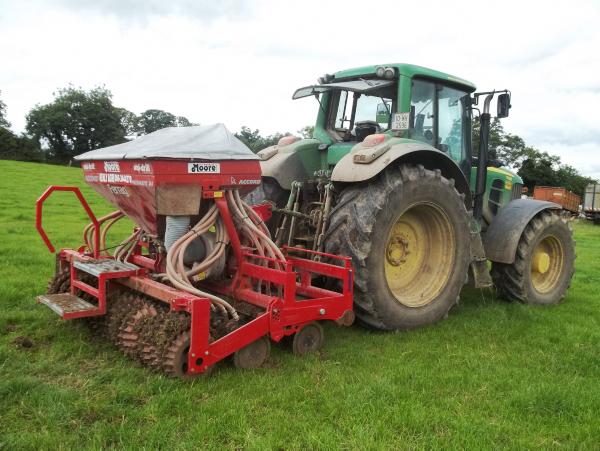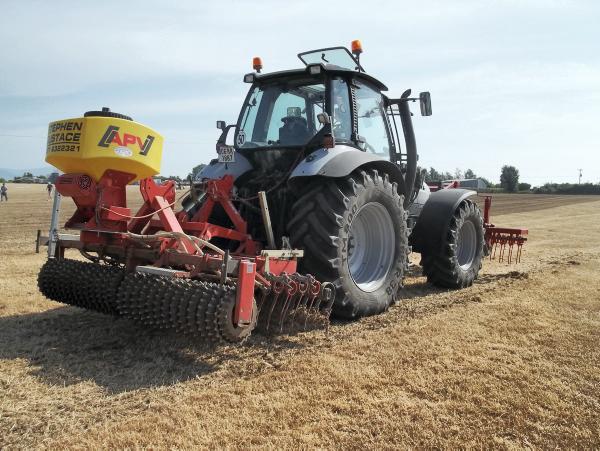John Coakley, a contractor from Co Offaly, has been using the Moore Unidrill for the past four years. This week, he received a lot of enquiries from dairy and suckler farmers planning on reseeding with the drill. He finds the drill useful because of the quick turnaround between sowing and grazing. The most common method used is to spray off silage with Roundup a week before cutting. Once the grass is cut and removed from the field, John moves in with the drill. Grass seed is drilled in at a rate of 12kg to 14kg per acre.
John advises his clients to spread lime on the reseeded field after sowing because any decaying matter from the old sward will leave the soil in an acidic state. The finer the lime is, the more accessible it will be to the soil and the quicker it should neutralise the pH of the soil.
Grass seed can also be drilled into bare open pasture preferably after cutting or topping, where paddocks haven’t been sprayed off. Again, the ph of the soil is important (ideally, 6.5). Any growth after completing the job should be grazed down tight after drilling until the new shoots start to appear.
The Moore Unidrill has a single disc that cuts a slot in the soil. Alongside the disc, there is a seed tube which directs seed to fall into the slot left by the disc. The seed tube also doubles as a tine and creates some soil disturbance around the seed. A Güttler roller follows the operation and thumbs in the soil to allow greater soil seed contact.
Last year, John sowed over 800 acres of grass seed with the Unidrill. He finds that it works well on difficult ground and stony land is not a problem. It costs €40 per acre to carry out the seeding operation.
Oversowing involves scratching the surface of the soil with a series of tines and spreading seed on the scratched surface. It is often used as a way of rejuvenating pastures. Michael Finnerty, a contractor from Ballinasloe, Co Galway, has been using the Einbok Harrow/Seeder for the past four years.
He maintains that damp weather is most suitable when using this system to encourage grass seed to germinate. Michael usually runs over ground three times with the 10mm tines to blacken the soil and pull up grass and moss.
The system works best if ground is bare from grazing or after cutting silage.
On the third round, he blows grass seed on the ground with the pneumatic seeder attached to the main frame. Michael advises farmers not to roll the ground afterwards. He says that rain will help seal up the ground or a coat of watery slurry works well also.
Michael says that under good sowing conditions, the new seedlings will outperform the old pasture.
Oversowing is a quick job to complete because the tines work best when driven at speed and they are covering a 6m-width. He says it is a cost-effective alternative to other methods of seeding and he charges €8 to €10 per run per acre, depending on acreage and other factors. This reseeding method is suitable for all types of land. Lime should be spread to counteract acidity from residues of the old sward.
Oversowing has been around for several years and some find it successful, while others don’t like it at all.
Adrian Elliott, from Glasson, Co Westmeath, has been reseeding with the Güttler direct-drilling machine and a ripping harrow for five years now.
The ripping harrow is made up of three rows of very strong tines. The front row of tines have a 12mm tip similar to the guttler tines, while the second and third row have 80mm x 10mm tines with furrow cracker forks at the tip of the tines.
The harrow gives a shallow till of the soil and creates a nice seedbed on the topsoil.
Seed is broadcast fully by the precision air seeder and is pressed down by the Güttler prismatic roller.
The key to successful reseeding with the Güttler system is preparation before seeding and management after seeding, Adrian believes. It is best to enter a field that has been burnt off and there is not too much trash present. If entering a field that has not been burnt off, then usually only hybrid grasses can compete so it is recommended to spray off old existing swards. This non-spray method suits for rejuvenating medium term leys rather than very old pastures, in general.
Some farmers with high stocking rates, who cannot afford a long turnaround between seeding and grazing, find not burning off the land a safer option.
The high stocking rate leaves them in a position to manage the reseed after sowing better because they will keep it grazed down tight.
The Güttler system is suitable for periods of broken weather. Adrian charges €55 per acre for one run of the Güttler and ripping harrow.






 This is a subscriber-only article
This is a subscriber-only article







SHARING OPTIONS: